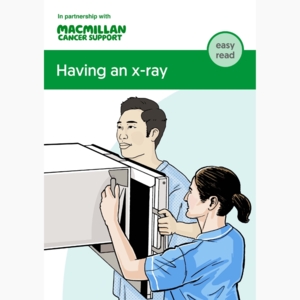X-ray
What is an x-ray?
Booklets and resources
Types of x-ray
The type of x-ray you have depends on the part of your body the doctors want to examine. Some common types include:
-
A chest x-ray
You have a chest x-ray to check your lungs are healthy, or to look for changes that may be caused by cancer.
-
An abdominal x-ray
This is to check the tummy area (abdomen).
-
A bone x-ray
This is to check whether there is a problem in a bone or joint, or to look for signs of cancer.
Chest x-ray
This uses x-rays to take a picture of the chest. You may have a chest x-ray to:
- check your general health
- look at your lungs and heart
- look for changes to the lungs that may be caused by cancer.
Having a chest x-ray is not painful. It only takes a few minutes. It uses a small amount of radiation. This is very unlikely to harm you.
What happens during an x-ray?
The person who does the x-ray is called a radiographer. They may ask you to change into a hospital gown. You will be asked to remove any jewellery or anything containing metal from your body. Tell the radiographer if you are pregnant or think you could be.
You may have the x-ray sitting up, lying down or standing. This depends on the part of your body being x-rayed.
After the x-ray
You will not have any effects after a standard x-ray.
X-rays expose the body to radiation. This can slightly increase your risk of developing cancer. But this is not common, and the risk is very small compared to the benefit of having the x-ray. Your doctor can tell you more about this.
You will usually get the results of the x-ray within a few days. Waiting for test results can be a worrying time. Talking to your family and friends about how you feel can help. You can also speak to your doctor or nurse if you have any problems, or need more support.
Date reviewed
This content is currently being reviewed. New information will be coming soon.

Our cancer information meets the PIF TICK quality mark.
This means it is easy to use, up-to-date and based on the latest evidence. Learn more about how we produce our information.




